Wednesday, July 27. 2011
-----
by Sarah Laskow

In the midst of this heat wave, it's hard to even remember what winter feels like. But for those inclined to plan ahead (way ahead) for freezing temperatures, Microsoft Research has a pitch for homeowners: Install a computer server where a heater would normally go.
It’s just an idea, but it’s based around the insight that, as the authors of the Microsoft Research paper write, “Physically, a computer server is a metal box that converts electricity into heat.” Servers’ exhaust air comes out at a scorching 104 to 122 degrees Fahrenheit. But that air is not hot enough to convert back into electricity. (The most common type of geothermal plant, for comparison, channels steam that’s more than 360 degrees.) Servers’ exhaust air is, however, “perfect for heating purposes,” the researchers argue. Channeling that excess heat could turn a regular old server into a “data furnace” that keeps homeowners warm in the winter, dries their clothes and heats their shower water.
As a widespread practice, replacing a run-of-the-mill furnace with a data furnace could save a lot of energy. Data centers use loads of electricity, and they’re only going to use more as more people stream and download more movies and music. But at least in the United States heating uses even more energy (6 percent of the national total, according to the Department of Energy) than servers do (3 percent). If servers doubled as heaters, we’d be getting the same services for half the energy cost.
Individual homeowners wouldn’t necessarily benefit from the switch. The Microsoft paper argues, in fact, that they wouldn’t even notice the difference. The companies running data centers, on the other hand, would benefit. According to the researchers’ back-of-the-envelope operations, the overhead cost per unit of running a host of data furnaces is about a fourth of the cost of running a conventional server farm. A big chunk of the savings comes from the convenience of housing the servers in buildings that people are already using: There’s no need for data centers to buy land and put up buildings with the sole purpose of sticking servers in them. They also save on cooling costs, because the heat they’d normally consider waste is going to good use.
The catch here is that few homeowners need heating year-round. The researchers assumed that heating would be useful whenever outside temperatures dropped below about 70 degrees. On warmer days, the heat would simply vent outside. On hot days, when temperatures top 95 degrees, the servers would have to shut down, since they wouldn’t have a cooling system built in. In places like San Francisco, the researchers calculated, the servers would be useful 96 percent of time and would virtually never have to shut down. In places like Dallas, on the other hand, they’d be useful only about half of the time.
But the Microsoft researchers allow that using servers as home heaters might be a stretch. Much more likely, they note, would be that larger buildings, like business complexes or apartment towers, would adopt the idea first.
Photo via the Department of Energy
Personal comment:
The new fireplace in the house is no more the tv set but the datacenter. Seems logical. Or, possibily, we should think about decentralized data centers, distributed in every house or appartement that would heat in winter and in summer... huh? Heat too? Maybe we could then even think of a seasonal computing: we could use our computers and the internet in Winter and early Spring, but not during Summer...
Via ArchDaily
-----
by David Basulto

Kanagawa Institute of Technology Workshop © Iwan Baan
The Kanagawa Institute of Technology Workshop by Junya Ishigami is an elegant rectangular box with with floor-to-ceiling glass, enclosing an interesting interior space with 305 columns of various sizes supporting the stripped roof of skylights. The columns, although seemingly random, are specifically placed to create the sensation of zoned spaces, but their nonrestrictive quality provides a flexible layout to suit the changing needs of students.
Now you can get a better sense of this space by using Google Streetview to navigate the interior, as seen on the above image (just drag it). For a larger view just follow this link.
Personal comment:
One of our favourite architects. But the center was looking much better without those posters or robots all over the place... And with flower or tree plants. Anyway, the "power user" (or rather the participant) is always right isn't it?
Tuesday, July 19. 2011
Via BLDGBLOG
-----
A slideshow over at National Geographic features this image by photographer Ian Wood, showing, in the magazine's own words, "what might be called extreme Inca landscaping."
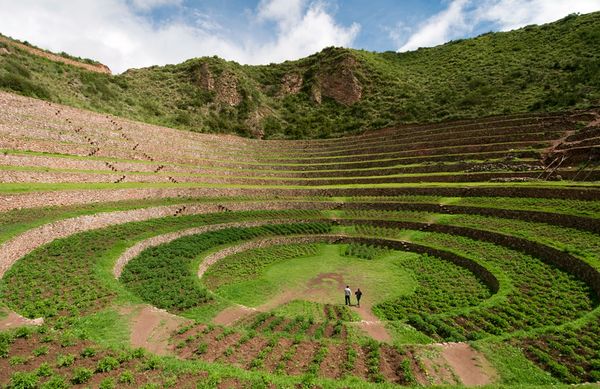 [Image: The weather bowl at Moray, Peru; photo by Ian Wood/Alamy, courtesy of National Geographic]. [Image: The weather bowl at Moray, Peru; photo by Ian Wood/Alamy, courtesy of National Geographic].
"Three enormous pits, each with beautifully curved sides that staircase down like the interiors of titanic flowerpots have been carved out of the earth to depths of up to 100 feet and more," the magazine adds. They are like Indian stepwells—only they concentrate thermal gradients—and this affects the local weather: "Air temperatures between the top and bottom layers can differ by more than 20 degrees, which has led some researchers to theorize that Moray was an Inca agricultural site where experiments on crops were conducted."
It's a site of experimental agriculture fueled by an act of microclimatic terrain deformation.
So does this mean that the weather at Moray should be subject not only to meteorological analysis, but to archaeological interpretation? The site you're excavating seamlessly continues into the sky above it, turning the weather itself into an historic artifact—a whole new spin on paleotempestology.
But is the weather created by an historic site also part of that historic site? If so, should ancient microclimates such as these be subject to material preservation? Put another way, if there were a Museum of Ancient Microclimates, how would you design it and what would the visitor experience be?
Imagine a whole constellation of these oversized weather pits, meanwhile, distributed throughout the Andes, all interacting with and augmenting one another, producing continent-scale storm systems—and imagine being hit by a summer downpour, or sitting calmly throughout the winter as blizzards rage just one valley over, knowing that the atmospheric events around you are really long-lasting cultural gifts of the people who lived there centuries before. Weather designed by your ancestors still rages around you today.
 [Image: From Sietch Nevada by Matsys; renderings by Nenad Katic]. [Image: From Sietch Nevada by Matsys; renderings by Nenad Katic].
Superficially, I'm reminded of the hexagonal "water storage banks" of Sietch Nevada, a speculative design by the San Francisco-based firm MATSYS. While the resemblance doesn't go much beyond form, this comparison lets us borrow MATSYS's idea of a water bank and, thus, reinterpret the Incan site at Moray as a kind of weather bank, storing temperatures and headwinds year round. It is a space to store climates in.
Extrapolating wildly from this, if the rise of the Himalayas radically altered the earth's climate by changing weather patterns for thousands of miles in all directions, then perhaps we can imagine a scenario in which a network of artificial pits in the Andes begins to affect the jet stream, plunging Australia into drought and pushing rain far north into Mexico—and that, in turns out, is those pits' very purpose, having been excavated by scientifically advanced, self-styled weather warriors more than 600 years ago for reasons still unclear today. Groups of elders would get together in the dark, sitting around their pits in tight circles as the winds picked up, burning incense, singing tales, hurling storms like artillery into the central Pacific.
(Thanks to Marilyn Terrell for the heads up!)
Monday, July 18. 2011
Via ArchDaily
-----
by Kelly Minner

Courtesy of Flickr CC License / kinerific
Manhattanhenge, is the term used to describe a biannual occurrence in New York City when the sun aligns with the east-west streets of Manhattan’s main grid. Adopted in 1811 the famous street grid of Manhattan, the Commissioners’ Plan, was the original design plan for the streets in which the grid plan is offset at 29.0 degrees from true east-west. Twice a year photographers gather to witness this urban solar phenomenon, when the sun sets perfectly between the skyscraper corridors and illuminates the north-south facades of the streets. Tripods and pedestrians filled the crosswalks this past Wednesday to catch a glimpse of this moment.
   
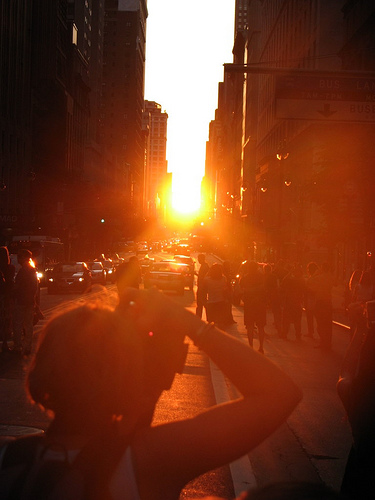
Courtesy of Flickr CC License / 4rilla

Courtesy of Flickr CC License / 4rilla
Friday, July 08. 2011
Via The Funambulist
-----
by Léopold Lambert

During the 1930′s, the United Kingdom wanted to reinforce its defense system against the growing antagonism that would end up in the Second World War. That is how they invented the RADAR (RAdio Detection And Ranging) but before such achievements, they experimented an architectural system on the Kent coast that would allow an early warning of potential enemy planes and bring an idea of their directions. Those monumental sound mirrors were reflecting sound into a microphone that was able to determine the direction of the enemy aircraft by determining which area has reflected sound the most.
In order to know more about them -which were eventually gave up before the beginning of the Blitz- you can read the article Listening for the Enemy written by Solveig Grothe for German magazine Der Spiegle.
Thank you Carla.
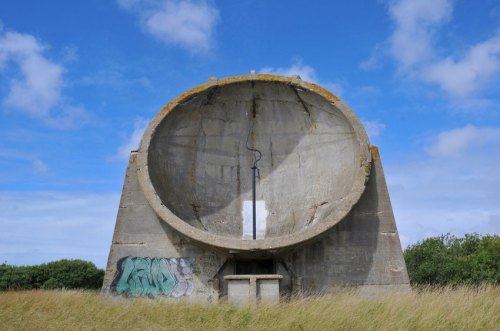
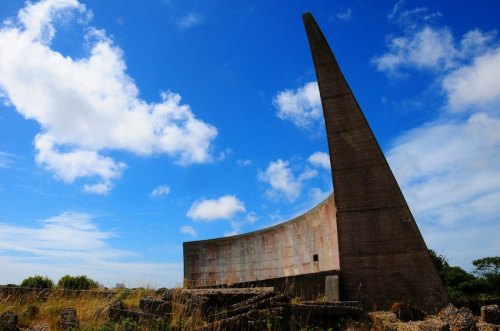
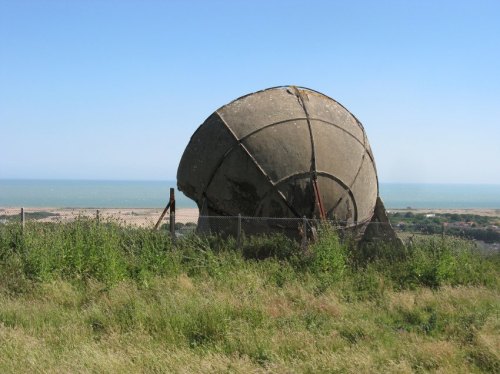
Personal comment:
Built "architectures" to amplify and (in a way) deterritorialize sounds.
|


 [Image: The weather bowl at Moray, Peru; photo by Ian Wood/Alamy, courtesy of
[Image: The weather bowl at Moray, Peru; photo by Ian Wood/Alamy, courtesy of  [Image: From
[Image: From 










